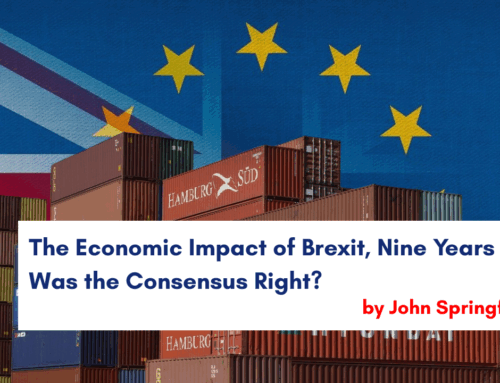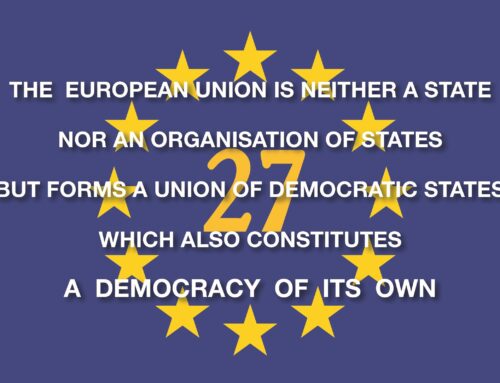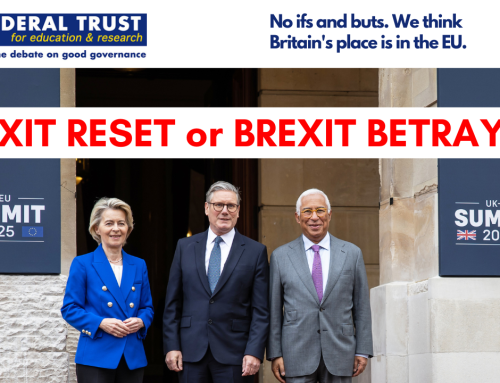No Deal, No Brexit, or May’s Brexit:
Getting to legitimate procedures for voting among the options
by Ira Straus
7th December 2018
About the Author
Ira Straus is the Chair of the Center for War-Peace Studies, which examines the use of complex electoral systems in holding plural societies together. In the 1990s, as Executive Director of The Democracy International, Ira gave close attention to consequences of independence referenda in post-Communist countries including Bosnia.
Referendum theory, in the spirit of classical direct democracy, indicates there should be a second referendum on the several options. Modern representative democratic theory, and the British constitutional tradition, indicates that Parliament should deliberate on all options and set up its own procedures for choosing among them.
Either way, all options need to be considered. This immediately raises basic questions: What options count? How to winnow down the options for a process of voting? With what processes to word them, amend them, and aggregate support around them? In what order to vote among the most serious options?
These questions are not unique to this case. For every issue that comes up, these same questions must be deliberated on. This is the main work of parliamentary assemblies: to prepare the terms for voting.
In the present case, the options are getting winnowed down to three: the PM’s Brexit Deal, No Brexit, or a No-Deal Brexit. The procedure is probably coming down to a Parliamentary vote on the PM’s Brexit, followed, if her deal is rejected, by a popular vote on the remaining two options. There is not yet however a consensus on this, nor the specifics worked out for it; matters discussed below.
PM May has pointed out that there are only three real possibilities: her Brexit deal, no Brexit at all, or a no-deal Brexit. This indicates a rather pressing obligation: to set up procedures for deciding among these options.
How to do this? There is no perfect way, but as we shall see, the PM already has indicated, perhaps inadvertently, a fair way.
Long ago, the economist Kenneth Arrow proved that, given multiple options, any fixed sequence of voting can produce a result contrary to what a majority would choose if the voting were held in a different sequence. It is a shocking fact. Even hyper-democratic voting devices, such as a transferable vote (STV), can have such perverse results, sometimes even more perverse. The only real way out is by using complex group processes for deliberation in order to develop decision procedures for each new issue.
This is why representative assemblies are needed. They work out the way to make a choice on each issue. Intensive, intimate, iterative communications; committee work; subtle evolved parliamentary procedures: these methods serve to aggregate factions and opinions around viable choices on an emerging issue, formulate the options in a fit manner, determine specific procedures for the vote or series of votes, and enable reconsideration or revision when needed. This too is imperfect, but it is the best solution yet found. It is why modern, parliamentary-style democracy has worked so much better than classical direct democracy; and why Britain has been suffering so badly after violating this norm with the Brexit referendum.
Theresa May has helped in this pre-vote deliberative process, intentionally or inadvertently, by winnowing the options down from the numerous theoretical ones to the three still-viable ones: her Brexit, no Brexit, and a deal-less Brexit.
She is right that these are the core remaining options. The negotiators and factions have run out the clock on all the others.
This simplifies the problem. But it still leaves a multiple-choice question. Which still creates an order-of-voting question.
Fortunately, the PM’s comment also logically implied a sound ordering for the voting: first vote her Brexit deal up or down. If it goes down, what would remain to be done is to vote on the two remaining options, no Brexit or a no-deal Brexit.
This makes sense. The Brexit referendum vote was for a Brexit-with-deal. The Government having negotiated the Deal, the first vote can be on accepting or rejecting it. If it is rejected, a second vote on the remaining alternatives — No-deal-Brexit versus No-Brexit — falls out like a precipitate from a chemical reaction.
And so we find an appropriate vote-ordering for this particular issue. It is not a perfect ordering; as Arrow proved, no ordering can be perfect. It is only the best ordering available.
It is encouraging that this appears to be the process toward which events and groups are drifting, somewhat inchoately. Deliberation has thereby begun to reinsertitself, willy-nilly, in the curious dance between Government and Parliament. It shows the resilience of Britain’s Parliamentary tradition, despite its damaged condition from the referendum and from Government methods. Repair is needed in it, and in the party leaderships, but the institutions live.
Parliamentary Vote or People’s Vote? Or both?
Under the PM’s plan, a vote on her Deal is to be held in Parliament. However, because her rhetoric has invested a mystical, super-constitutional authority in the earlier referendum, the Parliament feels a need to rebuild support for its lawful authority in this matter. It probably prefers to pass the issue on to the people for a second advisory referendum, and hold its own vote afterwards. It would be wise to do so.
The people evidently want to vote again, according to polls. And, in a series of polls taken since 14 November; the Government’s Brexit Deal is opposed by large pluralities, always more than 45% against versus 27% in favor; Remain has a slim margin over Leave but more than the pro-Leave margin in the Brexit vote (it is always at least 5% and shot up to 11% on 4 Dec); the Brexit Deal has a 10% margin over a No-deal Brexit; staying in the EU has a 10% margin over the Brexit Deal. (https://whatukthinks.org/eu/opinion-polls/uk-poll-results/ ) With many respondents undecided, and a documented tendency to be evasive when responding to pollsters who might think one’s view deplorable, a new popular vote would be needed for confidence on the main, Leave-versus-Remain choice. Forcing Brexit through without such a vote on these options would be an abuse of the prerogative; one perceived as severely damaging by the half of the country that is against Brexit, and as a serious enough abuse by the more than half that wants a second vote.
Referenda and reconciling a divided society
The PM rightly says that there is a need to bring the nation back together. No Parliamentary vote alone can do this. Referendums are divisive; it should not have been a surprise that the last one was. The nation was sharply split by the referendum. Even more troubling, Parliament was partly delegitimized by the referendum and by the PM’s rhetoric about its supreme moral status. Today, none of May three options, if voted up by Parliament alone, would be accepted as legitimate by a large disaffected sector of the public. Only a new referendum, paradoxically, can overcome this delegitimization created by the first one.
This is not as paradoxical at it seems. Multiple iterative referenda are in fact a procedure employed in the few countries, notably Switzerland, that use referenda wisely. A single referendum is not treated as a God-equivalent, never to be questioned. There sometimes have to be confirmatory or corrective referenda, after a defined interval or a new election.[1] This has the salutary effect of desacralizing any one referendum. The British people seem ready for such desacralization; YouGov finds they are ashamed not proud of the original Brexit referendum by a 36% to 18% margin. The Government’s upholding of the referendum as a superior authority for deciding Britain’s future is akin to a bubble that is sure to burst, and has rendered all authority somewhat fragile. A second referendum is the least harsh way of deflating the bubble.
Alongside a second referendum, steps are needed for soothing all sides. The sharpness of the final decision could be softened by Parliamentary or Deal wordings. If Parliament voted to remain after a referendum, it could mollify Brexiteers by explicitly reaffirming the right to reinvoke Article 50 if the UK concludes later that staying was a mistake. If it instead voted for the PM’s Brexit Deal, it could mollify Remainers by getting first an EU agreement that the UK could be readmitted on its previous terms, were it to later conclude that leaving was a mistake. Also, the national sides — Scotland and Northern Ireland — need soothed. Even if the UK stays in the EU, its crucial sentiment of cohesion will remain frayed by the Brexit scare. Fond words are needed such as Mr Cameron gave Scotland before its own referendum, not harsh retorts from a PM. A bit of skeptical education on democracy and referenda might also do some good.
Where the process is trending: Parliament 11 Dec., then People’s Vote
Since the above was written, it was conclusively determined that Parliament will vote on the May-EU deal 11 Dec.; and that if it votes the deal down, then it will be the Parliament, not the PM, that will determine how to proceed thereafter on Brexit.
This simplifies the problem. In the likely event that the Parliament rejects the May deal, the logical next step as of 12 December will be to pass it on to the people for an advisory referendum on the remaining two options: no Brexit or a no-deal Brexit. The final vote under law would revert thereafter to the Parliament.
And if she were somehow to get a Parliamentary majority to endorse her deal? It would still need to be passed on for confirmation or rejection by a popular vote, in order to achieve a safe level of legitimacy.
Parliament would presumably meanwhile instruct the Government to ask the EU for an extension of the Article 50 deadline, to provide time for preparing the referendum and final Parliamentary votes, or else get an extension by withdrawing the Article 50 notification and resubmitting it when needed.
[1] There have also been high, supermajority bars; and parliamentary interpolations into the referendum process and for reworking of options, implicitly reaffirming the role of parliament. These are all ways that wise countries have found for making it less dangerous when they reintroduce an element of direct democracy (referendum) into the better proven representative form of modern democracy.





